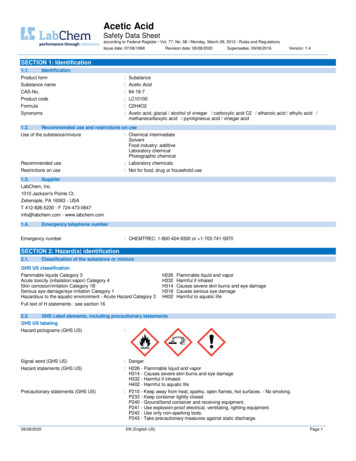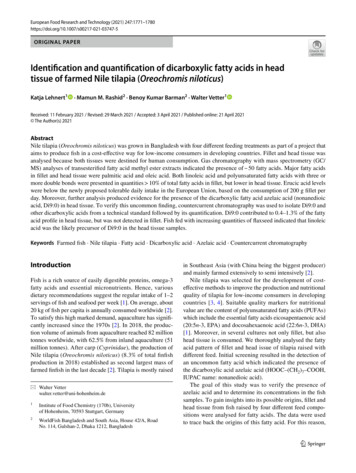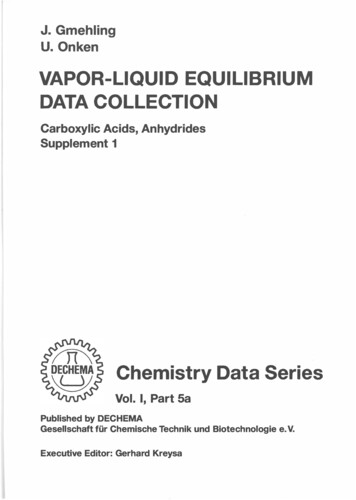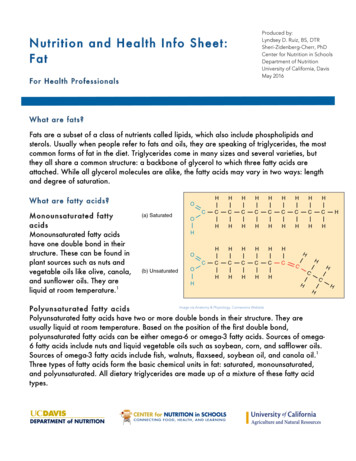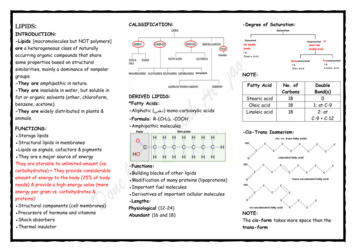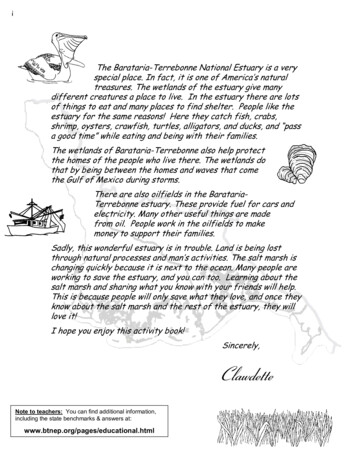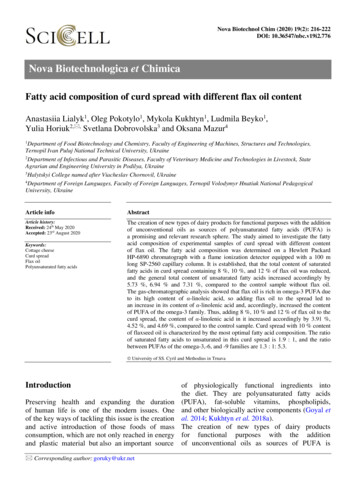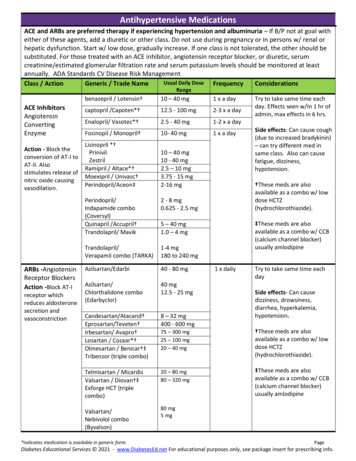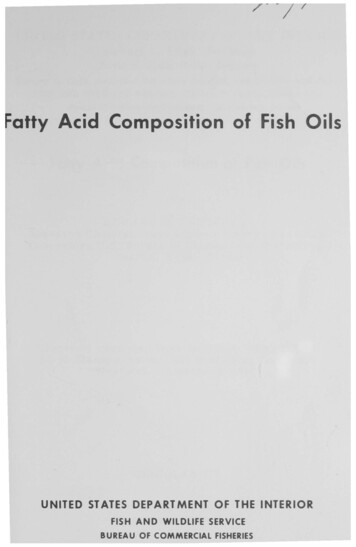
Transcription
Fatty Acid Composition of Fish OilsUNITED STATES DEPART MENT OF THE INTERIORFISH AND WILDLIFE SERVICEBUREAU OF COMMERCIAL FISHERIES
CHAPTER 1Ed'" ., OG"",,. J.IFatty Acid CompositionINTRODUCTIONI . of the chemical nature of fish-oil fatty acids and their dis arine life is important for the development of fishery ?ro?:the evaluation of the nutritional significance of fatty aCIds IIIoowledge of the distribution of fatty acids i also i por ant inrstand the physical and chemical properties of fIsh oils and(Xul role of fatty acids in fish and marine animals . and early developments of the fatty acid composition of fishocumented by Hilditch and Williams (1964) and by BaileyAlso, Lovern (1942, 1964) has reported extensive investigat the early era.Recent investigations continue to add tocurrent e:ru: -standing of fish oils, and one now finds renewed interest intil(' ma.lII lll.ll te es and classes of compounds associated with fatty acids ofmari ne 111 th tITL,,:)1 ter, some background information is given about the nature01 fatt)l llland their chemical distributions in fish oils, the origin offatty adj;· I fish, and the effects of environment on fish-oil fatty acids.FolloWJIll Ibackground information, a discussion is given about fatty.Kid mi obi l flfound in fish oils common to North America. Fish oils fromother aLl ' b the world are also included for comparison.N·"S OFFATTY ACIDS AND CHEMICAL DISTRIBUTIONSFi h Ii :rl:l marine-anima 1 oils are generally characterized by a rather1 rge .gr.',,o ! saturated and unsaturated fatty acids, which are commonly OCH t Imixed triglycerides. In addition to triglycerides, body oilstram fls Inarine animals usually include minor amounts of fatty acidsubs! , "of phospholipids and other lipids. In comparison to body.ner hand, liver oils and oils from particular parts of fish and, .s can often contain large amounts of fatty acids associatedloplds, glyceryl ethers (alkoxydiglycerides), and wax esterslthe source of oils and lipids (Lovern 1962). For a d t '}ll iasses of fish lipids see Chapter 2.e al eIdods derhed from fish oils are of three principal types: satu;".lturated, alld polyunsaturated. The formula,
Edward H. Gruger, Jr.ICHAPTER1Fatty Acid CompositionINTRODUCTIONKnowledge of the chemical nature of fish-oil fatty acids and their distribution in marine life is important for the development of fishery products and for the evaluation of the nutritional significance of fatty acids infish oils. Knowledge of the distribution of fatty acids is also important inorder to understand the physical and chemical properties of fish oils andthe biochemical role of fatty acids in fish and marine animals.The history and early developments of the fatty acid composition of fishoils are well documented by Hilditch and Williams (1964) and by Baileyet al. (1952). Also, Lovern (1942, 1964) has reported extensive investigations during the early era. Recent investigations continue to add tocurrent understanding of fish oils, and one now finds renewed interest inthe many types and classes of compounds associated with fatty acids ofmarine life.In this chapter, some background information is given about the natureof fatty acids and their chemical distributions in fish oils, the origin offatty acids in fish, and the effects of environment on fish-oil fatty acids.Following the background information, a discussion is given about fattyacid mixtures found in fish oils common to North America. Fish oils fromother areas of the world are also included for comparison.NATURE OF FATTY ACIDS AND CHEMICAL DISTRIBUTIONSFish oils and marine-animal oils are generally characterized by a ratherlarge group of saturated and unsaturated fatty acids, which are commonlyassociated with mixed triglycerides. In addition to triglycerides, body oilsfrom fish and marine animals usually include minor amounts of fatty acidsas substituents of phospholipids and other lipids. In comparison to bodyoils, on the other hand, liver oils and oils from particular parts of fish andmarine animals can often contain large amounts of fatty acids associatedwith phospholipids, glyceryl ethers (alkoxydiglycerides), and wax esters,depending on the source of oils and lipids (Lovern 1962). For a detaileddiscussion of classes of fish lipids see Chapter 2.Nature of Fatty AcidsThe fatty acids derived from fish oils are of three principal types: saturated, monounsaturated, and polyunsaturated. Tille formula,3
4FISH OILSCH 3 (CH 2 )x(CH CHCH 2 )n(CH 2 )yCOOHwhere n 0 to 6, illustrates the type of fatty acid structures common tofish oils.The saturated fatty acids have carbon chain lengths that generally rangefrom C 12 (lauric acid) to C 24 (lignoceric acid ). Also, traces of C 8 and C 10acids may be found in some fish oils. A C 5 acid (isovaleric ), however, occurs in jaw-bone oil of dolphin and porpoise.The monounsaturated type is comprised of monoethenoic acids, and thepolyunsaturated type is comprised of polyethenoic acids which containfrom 2 to 6 ethylenic bonds per acid. The carbon chain lengths of the unsaturated acids ;range generally from C 14 (9-tetradecenoic acid) to C 22(4,7,l0,l3,16,19-docosahexaenoic acid). Small amounts of C 10 and C 1 2monoenoic acids have been found in some fish oils. There are no naturallyoccurring acetylenic acids and hydroxy carboxylic acids presently knownin fish oils.Even-numbered carbon fatty acids make up about 9770 of the total fattyacids, with a few notable exceptions. It was relatively recent that oddnumbered carbon fatty acids were generally acknowledged to be part ofall fish oils. Branched-chain odd-carbon acids were isolated by Moriceand Shorland (1956) from shark-liver oil. They isolated 13-methyltetradecanoic acid, ( )-12-methyltetradecanoic acid, and ( )-14-methylhexadecanoic acid, and found that together these acids comprised 0.1-0.2% ofthe liver-oil fatty acids. Earlier work by Morice and Shorland ( 1952 )demonstrated the presence of other branched-chain acids in shark-liver oilthat resembled 2,3-dimethyloctadecanoic acid and 2,3,4-trimethylhexadecanoic acid. The application of gas-liquid chromatography by Farquhar et al. (1959) to the analysis of menhaden-oil fatty acids has alsodemonstrated the existence of straight-chain and branched-chain, oddcarbon acids of fish oils. Saturated and unsaturated odd-carbon fattyacids were isolated from menhaden oil by Gellerman and Schlenk (1959)and from mullet oil by Sen and Schlenk ( 1964 ), respectively. Normal andbranched-chain odd-numbered fatty acids in fish depot fats , seal blubber,and whale blubber were examined by Ackman and Sipos (1965). Theseworkers noted the ratios of iso and anteiso fatty acid to be comparable inthe fish and seal samples, but differed in a whale sample. (Cf. discussionunder heading of Fish Diets, p. 8).The nature of the ethylenic bonds in the unsaturated acids from fish oilshas been known for many years to be of the cis geometric configuration.In addition, however, evidence has been sufficient only recently to proveas far as is known that the carbon-carbon atom separations of the ethylenicbonds of polyunsaturated acids are of a methylene-interrupted type(Klenk 1958; Farquhar et al. 1959; Kayama et al. 1963B ). This type of
FArrY ACID COMPOSITION5separation is also referred to as a divinylmethane structure.urnerous investigators have shown that the divinylmethane structure is common as faras we know for individually isolated polyunsaturated acids of fish oil.Among these investigators, Silk and Hahn ( 1954 ) positively identified a6,9,12,15-hexadecatetraenoic acid (C 16 acid) in South African pilchard oil.The work of Klenk and Brockerhoff (1957) and Matic (1958) revealedthe presence of a 6,9,12,15-octadecatetraenoic acid (C 18 ) in herring oil andSouth African pilchard oil, respectively. The structures of 5,8,11,14,17eicosapentaenoic acid (C 20 ), 7,10,13,16,19-docosapentaenoic acid (C22 ),and 4,7,10,13,16,19-docosahexaenoic acid (C 22 ) were determined by suchworkers as Whitcutt and Sutton (1956); Whitcutt (1957); Klenk andBrockerhoff (1958); Toyama et al. ( 1959 ); Farquhar et al. ( 1959 ); Ackman et al. (1963); and Ackman (1964). Ahrens et al. (1959) were thefirst to point out that menhaden (Brevoortia tyrannus ) oil is composed ofat least 44 different fatty acids.Other workers have approached the problem of proving the general divinylmethane structure by analyzing mixtures of fish-oil fatty acids.Privett (1956) investigated the effects of lipoxidase catalyzed oxidationson concentrates of fatty acids, and demonstrated the 1,4-diene nature ofthe double bond structures. More conclusively, however, Hashimoto et al.( 1963) proved the gross divinylmethane structure in fish-oil polyunsaturated acids by analysis of nuclear magnetic resonance spectra.Chemical Distribution of Fatty AcidsThere are differences in the natural distribution of fatty acids associatedwith lipids such as triglycerides and phospholipids. For example, it isgenerally believed that phospholipids, such as lecithins and cephalins,contain more polyunsaturated fatty acids than do the triglycerides whenisolated from the same oil or tissues. Also, it is believed generally thatdepot fats consist largely of triglycerides, while the total lipids of variousbody organs and muscle tissues can by comparison contain large proportions of phospholipids. The reasons for such distributions are the subjectof much research, which will not be discussed here. It is only importantto point out some examples of these differences in order to understandbetter the composition of fish-oil fatty acids.To aid the following discussion, examples of the molecular structures oftriglycerides and phospholipids may be represented by the formulas for {3 oleodipalmitin and a' -oleyl-{3-eicosapentaenyl-a-lecithin, respectively, asfollows:
FISH OILS6oIICH 20C(CH2)14CH 3I I0CH OC(CH2)7CH CH (CH2)7CH3CH20 (CH2)14CH3,8-o1eodipalmitinoCH20 (CH2nCH CH(CH2nCH3I O (CH2MCH CHCH2)OCH3fCHI CH02POCH2CH 2N(CH 3)30HIOHex '-oleyl-,8-eicosapentaenyl-ex-lecithinAdditional information about the kinds of lipids associated with fattyacids may be found in such texts as those by Deuel ( 1951), Gunstone( 1958), and Hanahan (1960).Fatty acids of the triglycerides, lecithins, and phosphatidyl ethanolamines (cephalins) from livers of cod and lobster and from muscles of codand scallop were analyzed by Brockerhoff et al. ( 1963 ). They demonstrated that the polyunsaturated fatty acids were preferentially located in the(3 position of both the triglycerides and the lecithins. The phosphatidy1ethanolamines were also found to be highly unsaturated.Brockerhoff and Hoyle (1963) analyzed the fatty acid distribution inthe a and f3 positions of triglycerides from fish body and liver oils, andfound that the polyenoic acids were preferentially distributed in the f3 position. They also analyzed seal blubber and whale oils, and found that thepolyenoic acids occurred in the a position rather than in the (3 position ofthe blubber triglycerides.Lecithin fractions from tuna, salmon, and menhaden muscle were shownby Menzel and Olcott (1964) to have fatty acids distributed similar to thelecithins isolated from muscle tissues by Brockerhoff et al. (1963). Forthe three species, 91-99% of the fatty acids in the {3 position were unsaturated and 36-86% of the fatty acids in the a position were ,s aturated. Tuna
FATTY ACID COMPOSITION7lecithin, for example, had 8.470 20:5 1 acid and 3970 22:6 acid in the a position and 1570 20:5 acid and 48910 22:6 acid in the f3 position. In anotherinvestigation, for example, Schuster et al. (1964) showed that white muscle of five species of tuna contained cephalins and lecithins having 47%and 5070 of the 22:6 acid, respectively Other instances of fatty acid distributions in fish phospholipids are cited by Schuster et al. (1964).An interesting investigation of the triglycerides of sablefish (Anaplopoma fimbria) was begun by Dolev and Olcott (1965A), in which theyfound much less polyunsaturated fatty acids in the total triglyceride fraction than is customarily found in most marine oils. The most recent results of this work demonstrated that some of the a- and f3-substituentfatty acids of sablefish triglycerides do not follow the usual distributionalpatterns ( Dolev and Olcott 1965B). In this species, they observed for example that 18:3, 20:3 and 20:4 occur mainly in the a, a' positions compared to 14:0, 16:0 and 16:1 which occur mainly in the f3 position. The18:0 and 18:1 acids appeared to be distributed evenly. Notably importantwas the finding that 22:6, which was present in the glycerides, was notdetected as free fatty acid from hydrolysis by lipase.ORIGIN OF FATTY ACIDS IN FISHIt has been known for many years that the nature of fat in fish diets caninfluence the proportionate distribution of fatty acids in fish oils (Lovern1942) . Natural oils in marine plant life, planktonic crustacea, and otherplankton are consumed by fish in varying degrees depending on feedinghabits. Feeding habits of fish can vary according to such factors as availability of food, which may be a geographic factor, periods of fasting, andspawning cycles. The food fat metabolism in fish is being investigatedcontinuously in order to understand better the origin of the unique fattyacids in fish oils. To illustrate how the fatty acids of fish can change according to dietary fats, some recent findings are discussed .1 It has become common practice to use abbreviations when referring to particularfatty acids (Farquhar et al. 1959). Generally, the abbreviation is written as twonumbers separated by a colon. The first number designates the number of carbonatoms in the fatty acid molecule and the second number (after the colon) designatesthe number of methylene-interrupted cis ethylenic bonds. In addition, polyunsaturated fatty acids may be regarded according to families of which the terminalstructures are the same. For this reason, the position of the ethylenic bonds alongthe carbon atom chains may be designated b y the Greek letter omega or wanda number that refers to the number of carbon atoms separating the terminal methylgroup from the ethylenic bond nearest to the terminal methyl (Mohrhauer andHolman 1963). For example, 18 :3w3 stands for 9,12,15-octadecatrienoic acid( linolenic acid), and fish-oil fatty acids designated with an w 3 are said to belongto the linolenic acid family. Similarly, endings of w 6 and w 9 refer to the linoleicand oleic acid families, respectively.
8FISH OILSFish DietsExperiments by Kelly et al. (1958A) with mullet (Mugil cephalus) gaveindications that fish, like land animals, probably convert fatty dienoic acidinto tetraenoic, pentaenoic, and hexaenoic acids. Unlike land animals,however, the mullet seemed capable of converting 18:2w6 acid to a fattytrienoic acid. Other experiments have shown that young freshwater fishon low fat or cottonseed oil diets had no significant change in fatty acids,but when fed a diet containing other fish oil the fatty acids of the freshwater species changed to resemble the dietary fish oil (Kelly et al. 1958B).Similar results have been observed by Brenner et al. (1960, 1963), Meadet al. ( 1960), and Brockerhoff et al. (1964).In another instance, rainbow trout were fed for 103 days on a diet containing soybean oil. Results showed that no 20:4, 20:5, and 22:6 acidscould be detected in the trout oil after such treatment (Toyomizu et al.1963).Work on goldfish (Carrassius auratus) by Reiser et al. (1963) demonstrated that controlled diets depleted of polyunsaturated fatty acids, butcontaining principally 18:0, 18:1, 18:2 and 18:3, produced changes after76 to 120 days in fatty acids of both triglycerides and phospholipids. Itappears from their data that the triglycerides in these fish showed significantly less 20:5 and 22:6 acids when compared to the phospholipids.Marine plankton, as a major food source for fish, have commanded theattention of scientists in recent years. Crabs and shrimps, which when immature are included in the crustacean class of plankton, are known toexhibit fatty acid changes in body fats analogous to fish, depending ontheir diets ( Kelly et al. 1959 ) . Klenk and Eberhagen (1962A, B) isolatedfrom marine plankton a group of polyunsaturated fatty acids, which arelike those found in fish and marine animal oils. Others have also shownthe similarities between the fatty acids of fish oils and plankton-oil fattyacids (Farkas and Herodek 1961, 1964; Lewis 1962; Kayama et al. 1963A).Ackman and Sipos ( 1965 ) examined a number of samples of fish oilfatty ' acids and made a detailed study of the saturated fractions. Theynoted that the normal odd-numbered fatty acids found in marine lipidsoriginate in phytoplankton, but that there is little evidence to indicate thatbranched-chain fatty acids are prominent in these plankton. It is suggested that branched-chain fatty acids are formed to some degree in zooplankton.Biogenesis of Fatty AcidsIn order to understand how fatty acids are transformed or convertedfrom the food chain to the fat and oil depots in the fish, it has been necessary to investigate what happens to the individual acids after ingestion.
FATTY ACID COJ\[POSITION9Klenk and Kremer (1960) showed that when radioactive carbon-14 labelled acetate was incubated with liver slices of frog, carp, trout, flounder,smelt, and dab, the C 20 and C 22 polyenoic acids were synthesized fromlinoleic and linolenic acid precursor.Kayama et al. (1963B) tested the supposition that dietary linolenic acidis incorporated in toto into the carbon chains of 20:5 and 22:6 acids of fish.U sing mature kelp bass ( Paralabrax clathratus) for intraperitoneal injections of methyllinolenate-I-C14 diluted with pure methyl lin olen ate, the investigators found that the acid of the latter ester was converted to 20:5acid and that the 20:5 acid was incorporated into 22:6 acid. The probable conversion pathway for linolenic acid is as follows : 18:3w3 18 :4w3 20:4w 20:5w 22:5w3 22:6w3. This indicates a retention of thelinolenic-type structure throughout the conversions. However, it ispossible, as Kayama et al. (1963B) pOinted out, that the linolenic add,unlike linoleic, undergoes extensive partial degradation and re-synthesisbefore chain elongation to the final products.ENVIRONMENTAL INFLUENCE ON FATTY ACID COMPOSITIONIt has been observed in the past that environmental factors such as geo-graphic locations of catch and seasons of the year, which may be related towater temperatures, are related to the proportions of fatty acids of fish oils(Lovern 1942; Swain 1953) . Re-evaluations of these factors have been important in light of modern instrumentation like gas-liquid chromatography(GLC) (Farquhar et al. 1959). Seasonal variations in fatty acids of commercial cod-liver oils were investigated by DeWitt ( 1963). He observeda range in iodine values, 146 to 168, for GLC analyzed fatty acids of theliver oils sampled from May to November.The influence of season, as well as water temperatures and pressure effects, was observed by Lewis (1962) on f tty acids of Arctic plankton.When comparing plankton fatty acids from Arctic plankton and ·California coastal plankton, Lewis (1962) found two changes in the fatty acids,namely, an increase in the degree of unsaturation and a reduction in chainlength with a reduction in environmental temperature.It is unfortunate that Lewis (1962) reported for some two dozen speciesonly those fatty acids with GLC retention times up to that of 20: 1. Rodegker and N evenzel (1964) point out that this indicates only about 45 to90 0/0 of the total component fatty acids to be anticipated. Lewis (1962)proposed the ratio of 16:0 to 16: 1 acids as a valuable index of the temperature of the habitat of marine ectotherms. However, in the work by Rodegker and N evenzel (1964) on fatty acids of mussel, barnacle, and starfish, only one of their samples agreed with the 16:0 to 16:1 ratio reportedby Lewis. They suggested that problems may be due to attempts to com-
10FISH OI.L! rare fatty acids of different tissue types and, hence, different lipids whichmay have different biological functions. Rodegker and Nevcnzcl (1964)suggest that a clear picture of temperature effects, etc., would be anticipated from analyses of the same type of lipid fatty acid source, say for example the muscle phospholipids.The effects of temperature on growing mullet (Mugil cephaZus) andgoldfish (Carrassius auratus) were investigated by Reiser et ai. (196.3).They concluded from analyses of fish raised in water at l.3 C. and at 23 C.that these temperatures had little or no influence on the deposition or interconversion of polyunsaturated acids in the mullet. These findings weresurprising. Based on controlled diets, they reasoned that possibly saturated fatty acids ( 12:0 and 14:0 ) are not absorbed at the lower temperature,thereby 'causing a lack of significant influence on the unsaturated fattyacids. Contrary to these findings, however, Kayama et aZ. (1963A) havedemonstrated that guppies ( Lebistes reticuZattls) raised in \\ ater at 17 C.possessed more 22:6 acid in the oil than did guppies raised in water at24 C.In other work, Farkas and Herodek (1964) showed that the amount ofC 20 - C 22 polyunsaturated acids in freshwater planktonic crustacea increased with decrea ing temperatures, and in some species these acidsexceeded the values common to marine animals. The fatty acids of freshwater fish which fed on these crustacea resembled fatty acids of marinefish. One might say then that temperature had an indirect influence onthe fatty acids via the food chain.NATURAL FATTY ACID \UXTUREow that we have discus ed somewhat the chemical structures associated with fatty acids of fish oil , the origin of fatty acids, and the influenceof some environmental factors upon the natural patterns of fatty acidmixtures, it will be easier to evaluate the fatty acid compositions of fishoils. The mixtures of fatty acids to be discussed below are related to fishoils and marine animal oils that are common principally to 0.' orth America,but oils from elsewhere in the world are included for comparison.Fatty acid compositions of fish oils have been known for many years tobe complex. Only after the development and widespread application ofgas-liquid chromatography (GLC) to the analysis of fish-oil fatty acidshas this complexity become more vivid (Ahrens et aZ. 1959). The resultsof GLC have provided the data given in the subsequent tables. The technique of GLC is discussed in another chapter.The fatty acid composition of some body oils from marine and freshwater fishes and marine animals are listed in Table 1. Tables 2 and 3show similar compositions for oils of shellfish , and fish-liver and ega0 oils ,
TABLE1FATTY ACID CO MPO SITION OF BODY OILS OF MARINE AND F RESHWATER FISHES IFatty Acid Percentage CompositionN a01r of SpeciesCommon17:018 :0NKNK0.86. 17.2124.214 .916.52.41.13.69.7NKNK0.90.1NKNK\ 5.6 20.84.0 20.32128.4 16. I1 .89.01 .6 10.74 .0 11.83.47.84.7 14 .53.3 30.01.2NKNK1.20.31 .02.5Squalus acanlluulNKPrognichlhys "goo3.31.91.82.01 .47.26.54.66.05.75.92.7NKNK1 .71 .20.9NKNK3.03.72.92.73.02.311.722.024.716 . 127.533.616.510.91.72.32.21 .30.61.51.1Prn,e,mch!hys agon3.51.220.56.73. 16.920.31.4NKAcanlllOgobwsjluuimanusClulidonichths lIsAferluccius productluGlupea harwgllsCoregonus ar/edi,Clupea harenf!.uspal/asi 'Clupea harenguspal/aS!Clupea harenguspallasi5.42.2NK1.412.820.29 55.8NK2.02.310.426.211 .81.43.40.71.1NK0.513.922 . 72.84.71.21.58.95.310.915 .69.012.3 .43.02.21 .90.65.523.2.1317.718 .33.613.5 --'NKElrumeul TnlCrOpUs3.7Elrumeus microplH5.7Sardo chrlmsisBuucrlishCapdin (maidCapdin (female)Cod. AtlanlicCod. AtlanticCod, Pa(" i fieCentr%pltus japonicusAl allolus oil/os usAlallotus vil/osusGadus morhuaGadus macroceph 'dusg t : shAslrocongrr myriasttrOmmastrtphes slo,,,,iDoglishDogfish. PikedDogfish. Spin)Dogfish. Spin)Flatfish qualus suckliiSqualus acantluo.fSqualus oranthrasHalibut. PacificHalibutH alibutHake. PacificH erringHerring. LakeHerring. PacificHerring. Pacific(dorsal)Herring, Pacific(ven"'al)H(·ITin .Gadus g-, Roundh("ntral)NKNK16: 1BonilO(dorsal)Flying fish("entral)Cob)'Gob)'15:01.62.971 .38.88.61.80.41.05.516:0Lop/llomus setl erusSphyraeno s,Mgt!jFlying fish14 :028.217.21718.612.013 .333.424.118 .217 .8ScientificAnglerBarracl lda7.6 NKNK0.50.1 67.18.3I 118: 118:23.51 .1118 :3-,--'-, NKNK0 .80.1-,-,-,1.1NK0.60.50.8-,-,0.3--'-,0.3 3.40.618: 420: 120: 420:522: 122:522:6ReferenceNKNK2NKNKNK1 .20. 1NK1.61. 7' - ,1 . 8 ,--- 1NK4 .6' - ,2 1 .5 NK17 .2 NK1.63.21.23.72.0' --'4 .9' --'5.517.2223.75.88.612.417.617.98.05.2' NK1.4' 1. 22NK6.1' 4 . 418 .50.514 . 20.90.70.61.10.95.6' 1 .93.13. 4'11 .825.73 1.43.64 .821.937 .529.27.8Shimma 1964AShimma 1964AKlenk 1962Shimma 1964AAckman 196 3Ackman 1963Cruger 1964Ackman 1964 BShimma 1964AShimma 1964A1.9NK1.30.7NK0.7NK11.22. 112 .6' --- 5.22.75.82.52.86.411.91.91.8' --- 5.98.78.37.96.511 .94 .810.84.4'4 .04.13.54 .8 32.93.52.72.31.71.3NK10.516.021.810 .47.015. 425.6Ito 1963BShimma 1964AOlley 1965C ruger 1964Malins 1965Ito 1963BShimma 1964ANK7.5' --"4 .73.4'2.916.6Shimma 196 4A1 .2NK18 .60.93.2' --"3.515 .612 .54.4 31 .43.93.311.8Ito 1963 BShimma 1964ANKNK1 . 3' --"3.51.87 .314 .34 . 1'NK2.40.738.824.3Shimma 1964ABeare 1962g8.010 . 15. 11 .67.9Cruger 1964Z2.82?37.612.65.02.319.2Olley 196512.863.45.90.48.60.7162.811. 67.8613.37.6Stansby 1966Klenk 1962Cruger 1964Cruger 196422.5S himma 1964AShimma 1964A3.6NK21.82.82.54 .014 . 4 7.70.713.31. 353 2NK24.94.9NK14.17.11.821. 71.7--'NK3.80 .927 . 26.21.77.312.11.4--'NK1 .4' --- 10 .23.23 NK24.1Shimma 1964A1.316.37.83.07.414.51.9-,NK3.0' --- 10 . 13.5 320.3Shimma 1964A ! JNKNK7.4' --"19 .2'11 . 44.68.6' NK19.9 33.7 (")o "doenOlley 19656.1NK I-'I-'
TABLELoachMackerelMackerel, HorseMackerel, JackMenhadenMenhadenMenhadenMu llet, SlripedMullet, StripedMullelMull .Perch, OccanPerch, O(' anPilchardScientificMi.rgurtlus lo-rsi/fI.!Scomber sCfombrusDecapterus [ajangCaranx merlensiBrevoorlia [yrannusBrev(}()f'tia tyram-wsBrevoorlia tyrannusA1ugil cfphalusMug" up/lalusAlugil crphalusMugil uphalusSebastes marwwSrbaslu marinusSardinops sagax;(continued)f-'tvFatty Acid Percentage CompositionName of SpeciesCommon114:015:02.24 .92.4NK7 .27.78.04 .67.53.95.35 54 .67.6NK0.50 .6NK0.5NK0.56.34 .57.411.2NKo6o61.916:016: 117 :018:018 : 118 . 428.233.018 .817 025.328.917 .313.929.632 023.012 616 .216 .75.34.41.29.86.77.911.015 .56.36.03.88.09.2NK1 .05.93.913 .710.73 10.4NK3 11.04.00.85.01.05.15.54 .81.22.0NK3.91.03 60 .73.514 .719 .312 .319 614 515 .413 . 48.49.15 84.618 .522 011. 43.0NK18 .3 NK18:218 :36.27.6'1.11.32.72.2 - '2.71 31.6NK1.10.93.21.42.21.02.G1 .51 50.81.6 NK1.5o60.91.3-,18:4NK3.4NKNK3.24 .01.93.03.1NK0.6NK1 .62.020: 120:420:522: 1-,---'4 .27.14 .83.712 .512 .910 .27.511 .84 .75.07.99.316.92.58.6' 2.72.81 .2 10 .820.53.6' NK3.7' 3.0 34.2NK2.18.9NK2.3 14 . 01 .71.6 12 .80.73.9 13.4NK3.23.2NK3.1 10.3NKNK5.7?NK13 .68.70.6 12.03.82.5 12.93.13.92.0' ---'3.2' .00.83.21.622:522:6 ReferenceShimma 1964AGruger 1964Shimma 1964AShimma 1964AAhrens 1959Peifer 1962Grugcr 1964Gruger 1964Gruger 1964Peifer 1962Sen 1964Peifer 1962Gruger 1964Ackman 1964Sardmn/lr caffulrnPuffcrSphorroit!esRedfishR ockfishSablefishSab lefishS,bastu sp.S,haslodes /lWIll.l!.l'fAnoplapoma fimbriaAnoplopoma fimbTl"Oncorhynchustshawy/seliaOncorhynchus k,/oOncorhynchus ,lcttaNK29.7NK4.14 .64.13.7NK0 .6o4o50 .423.114 .918 114 . 816 .612 43 05 .56.68.011.69.2NK2.6o81 01110 76.03 13 85.814 420 820 438.029 14 81 6o82 11.12.26.20.6NK17.016.34.18.311NK3 22.721 424.82 01.4Oncorhynchus keta6 .6NK13 5Oncorhynchus kisulchOncorhynchus kisulchOncorl·ynchusgorbuschaNKCtupta p.lch"rdusC%abis sairaLot(olobraxjaponicusTaius lunllfronsChrysopl.yrs maJOTPhoca viLultnaconcolorDorosoma lhflssaDorosomo tllT/ ssa"Lam no comubicaNKfiypomeslls olrdu\Pleocoglossujaltir"iJ3.73.73.4o 5 IIIvermrcu{anjSalmon, Chinool.Sa lmon, ChumSa lmon, Chum(dorsal)Sa lmon, Chum(venlra l)Sa lmo n, CohoSalmo n, S il v("rSa lmon, PinkSa rdineSard ine, Penl\'ia nSaury, PacificSea bassSea-bream, " K i"Sea -brea m. " M a"S(,al, Harbo rS had (dorsa l)Shad (ve ntra l)S ha rk, Porbeag lcSkipr.0rS In(, l , Po ndSmell , Sw(,etNK1.09.0NK2.825.31.9222.510.26 75.05.0o94 73.94.418.623.617.61 20.91 69.5105.48.8NK17.3147.316.92.511.71 .7NK1.6-'-,o80.51 .30.91 0-'NK1 .31 .3NK1.52.0NK5.414.4'NK15.7' - '5 14.8' NK17.1Shimma 1964A1 .50.81.00 .56 111.78 54 .68.23.7' NK0 .81 68.91 84.1? NK3.62.426.617.412.12.25.9Shimma 1964AGruger 1964Gruger 1964Dolev 1965Gruger 19640.96 76.59.42 312.8' NK16.16.6Grllger 1964Shimma 1964A-3-36.814 8o91.4o712 011.013 55.5NK3.52 93.33.113.812.916.9Gruger 1964Peifer 1962Gruger 19642.934 72.68.12.52113.8' ---'1.9' - ,9.6226.610.67.814.7'3.1' 2.821 .21.88.5413.52 1. 8I to 1963BKle nk 1962Shimma 1964AShim ma 1964ANKNK0.73 I' ---'2.7' -"13 6o53.912 25.54.2'7.3'6.02.92 84 323.411 .37.5Shimma 1964AShim ma 1964AJ a ngaard 1963 AI 22 9NK2.35 9NK17.2' N K1 5' - 32.1' - 34 . I' I 213 4o92.7' - .8 48.02.88.413. 42. 42. 1' N K0.9' 1.41 .5? 13.71. 713.82.8' 1. 51.21 1 .328.510.929.012.028 .91. 3S himma 1964AShimma 1964AShimma 1964AIto 1963AShimma 196 4AShimma 1964A2 1NK2 9 -,1.31.0I INKNK15.51918.420. 12 33.731.55.91. 32.83.3NKNKo130.426.76.55.05.817.6NK1. 20.18. I10.30. 415.815. 430.21 .91 .50 .8-,4.59.72.56.91 .97.3NK0.8NKo7NKI I24 .522.012.213. 422.529. I5. 19 .58 .15 16. 415.0NKNKNKNKNKNK5 85. 12. 42. 43.82.616.822.916.810. I11. 311. 51. 62.71.02.31.14.8-' NK4 .7' - '5. l'1.45.66 6?4.7o66.686.92.5 0.7NK-,o2.-'-,8.45.34.0-'-'NK3.6Shimma
4 FISH OILS CH3(CH2)x(CH CHCH2)n(CH2)yCOOH where n 0 to 6, illustrates the type of fatty acid structures common to fish oils. The saturated fatty acids have carbon chain lengths that generally range from C12 (lauric acid) to C24 (lignoceric acid ). Also, traces of C8 and C10 acids may be found in some fish oils.

